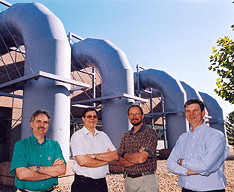|
Sandia spins off company to commercialize microsystems technology
|

MEMX SPINS OFF— These four Sandia researchers have agreed to join a private spin-off company, MEMX, Inc., to commercialize Sandia-developed microsystems technology. They are, from left, Paul McWhorter, Sam Miller, Jeff Sniegowski, and Steve Rogers. (Photo by Randy Montoya)
Download 300dpi JPEG image, ‘MEMSteam.jpg’, 1.8MB (Media are welcome to download/publish this image with related news stories.)
|
ALBUQUERQUE, N.M. — In a “bold and important move,” Sandia National Laboratories has spun off a private company, MEMX, Inc., to commercialize Labs-developed microsystems technology.
Sandia, a Department of Energy national laboratory, is recognized as a leader in the field of microelectromechanical systems (MEMS) and microsystems technologies. MEMS are complex machines with micron-size features.
The new company will initially focus on producing optical switches for the telecommunications industry using SUMMiT V, an advanced five-level polysilicon surface micromachining MEMS technology that produces more reliable and complex devices than previously possible with less advanced techniques.
Al Romig, Sandia vice president and chief technical officer, says the spin-off of this new company is a “bold and important move” and falls in line with Sandia’s core mission.
“This step is important for the commercialization of MEMS and fits in with Sandia’s primary mission — national security,” says Romig. “We believe commercialization of our MEMS technology is critical for us to achieve our national security mission. National security decision makers are conservative. They want to see the technology widely used in applications like cars or television before they consider it for weapons. Getting the technology out of the labs and into commercial applications will give us the confidence needed to deploy it in critical defense applications.”
David Williams, director of Sandia’s Microsystems Science, Technology, and Components Center, says MEMX will be the “cornerstone” of the new microsystems industry that Sandia and others are striving to create. One of the first steps is to have a company, like MEMX, commercialize the Labs’ MEMS technology.
“Commercialization of any emerging disruptive technology is a challenge,” Williams says. “We believe that small and entrepreneurial companies are key to getting the technology into widespread applications. MEMX will play a critical role in achieving this objective.”
Paul McWhorter, one of the company founders who has been deputy director of the Microsystems Science, Technology and Components Center, anticipates considerable interest in the optical switches due largely to the explosion in demand for bandwidth created by the Internet.
“Optical switching applications are a driving force in the MEMS arena right now,” McWhorter says. “We believe Sandia’s SUMMiT V technology is ideal for meeting not only today’s need for high-performance optical switches, but for the needs of next generation higher performance systems.”
McWhorter predicts growth in demand for e-commerce and multimedia applications over the Internet will continue for at least 20 years. Companies such as Lucent, Nortel, Cisco, Marconi and Corning are racing to achieve optical routers and other optical switch systems to meet this demand.
“A key challenge is that traditional techniques for performing optical switching can’t keep up with the explosion in demand,” he says. “Optical switches present the ’speed bumps“ on the information superhighway.”
Significant progress has been made in increasing the amount of data that can be pushed down a fiber; the amount of data that can be transferred is doubling every eight months. Switching this data is traditionally done by converting the optical signals to electrical signals, switching them electronically, and then converting them back to optical signals. The fundamental limitation: today’s electronic switches destroy the wide bandwidth advantage of the optical fiber. Optical switches eliminate this problem.
“Because they are batch-fabricated using standard integrated circuit manufacturing techniques, MEMS offer an affordable technique for creating large arrays of high-performance mirrors on a single silicon chip,” McWhorter says. “Standard switches used in fiber optics can cost up to $1,000 per channel. If you use 1,000 channels, the cost is $1 million. Using MEMS technology, you can put 1,000 mirrors on one chip, which can be built for just a few dollars.”
MEMX has licensed Sandia’s unique intellectual property, and company founders plan to advance the technology aggressively.
While the initial focus of the company will be on optical switching, McWhorter says the company will broaden its product line later. He anticipates “a lot of growth in the first year.” The company is also expected not only to be a supplier of commercial technology, but also a potential supplier back to Sandia for national security applications.
Joining McWhorter in the MEMX initiative are Sandia researchers Jeff Sniegowski, Sam Miller, and Steve Rogers. Sniegowski and Rogers developed the five-level MEMS technology.
MEMX will be headquartered in Albuquerque, N.M. The company will use manufacturing facilities at Sandia’s Microelectronics Development Laboratory (MDL) to produce its first prototype, but will quickly build its own fabrication facility.
MEMX was organized by TMA Ventures of Denver, Colo., an enterprise specializing in the commercialization of high technology. Sherman McCorkle, president of Technology Ventures Corporation of Albuquerque, also played an instrumental role in the founding of the company. Michael McIntosh and Patti Pickell of TMA Ventures will join McWhorter as the company’s start-up management team. McWhorter will be MEMX’s chief technical officer. Start-up financing is being provided by Investco and Council Capital Management, LLC, both of Nashville, Tenn. Angelo Salamone of Sandia’s Technology Transfer Office, Gerald Grafe and John Hohimer of Sandia’s Legal Office, and Jay Jakubczak of Sandia’s Intelligent Micromachine Department negotiated the license with MEMX.
Sandia is a multiprogram laboratory operated by Sandia Corporation, a Lockheed Martin Company, for the United States Department of Energy under contract DE-AC04-94AL85000. With main facilities in Albuquerque, N.M., and Livermore, Calif., Sandia has major research and development responsibilities in national security, energy and environmental technologies, and economic competitiveness.
Media contact:
Chris Burroughs, coburro@sandia.gov, (505) 844-0948
Technical contacts:
Al Romig, adromig@sandia.gov, (505) 844-8358
David Williams, wdwilli@sandia.gov, (505) 844-7659
Paul McWhorter, paul@memx.org, (505) 858-1062
|
